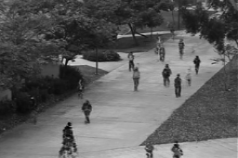About me
My name is Thomas Golda and I’m a research assistant at the Karlsruhe Institute of Technology, working in close cooperation with the Fraunhofer Institute for Optronics, System Technologies and Image Exploitation IOSB in Karlsruhe (Germany), which is one of the largest research institutes in the field of image acquisition, processing and analysis in Europe.
The focus of my work is centered around the two topics:
- Machine Learning / Deep Learning
- Computer Vision
Open Positions for Students
I’m always looking for students supporting me with my research. Some currently available topics are listed below. Topics for thesis or “Hiwi” positions are not limited to those below, so don’t hesitate to ask me for other related positions.
→ NEW: Keypoint Tracklet based Anomaly Detection (BA/MA)
→ NEW: Uncertainty Quantification in Crowd Analysis (BA/MA)
→ Crowd Motion and Behavior Analysis (Hiwi/BA/MA)
→ Supporting Student Position for Research on Human and Crowd Analysis (Hiwi)
Research Topics
Based on these general interests, I’m working in three main fields: anomaly detection, human pose estimation and crowd analysis. I try to develop and apply machine learning methods in order to tackle all those tasks. You can find more information about the fields below.
Tip: You are a student in Computer Science, Mathematics, Electrical Engineering, Physics or other related fields looking for a research topic for your thesis? You are motivated to work on challenging and interesting tasks? Feel free to contact me.
Anomaly Detection
 Anomaly detection is a very important topic in almost all fields. First of all, it is important to know what an anomaly actually is! The task can range from detecting anomalies in circuit designs, to abnormal packages within a network, to salient behavior of a person or group of persons. In my work, I focus on the latter. My main work focuses on applying generative approches like Generative Adversarial Networks (GAN) and analyzing time series using Long Short-Term Memories (LSTM), Recurrent Neural Networks (RNN) and Hidden Markov Models (HMM).
Anomaly detection is a very important topic in almost all fields. First of all, it is important to know what an anomaly actually is! The task can range from detecting anomalies in circuit designs, to abnormal packages within a network, to salient behavior of a person or group of persons. In my work, I focus on the latter. My main work focuses on applying generative approches like Generative Adversarial Networks (GAN) and analyzing time series using Long Short-Term Memories (LSTM), Recurrent Neural Networks (RNN) and Hidden Markov Models (HMM).
Human Pose Estimation
Extracting the pose of a person can be useful for different reasons like activity recognition and motion capturing. For example, within the medical field, extracted poses can be used to analyze the movement of limbs of a person rehabilitating from an injury or to detect malfunctions in the human locomotive system. Due to lots of occlusions, the task of robust and reliable human pose estimation for multiple persons gets quite challenging. Furthermore, working with abstract poses allows us to preserve the privacy of a monitored person. My work focuses on using human body poses for abnormal behavior detection. This can range from certain activities that can be clustered as violence, but also tumbling people or people laying on the ground.

Crowd Analysis
Analyzing how people move (from a macroscopic point of view) and being able to estimate the number of people within a certain area are important and quite challenging tasks. With the increasing number of huge events and people moving around in urban areas, it gets more important to characterize crowded situations. Especially from a security point of view, it would be great to be able to predict how the distribution of people within a certain area will change within a certain time interval. Which region will be very crowded in five minutes? Are there any salient patterns within the movement of the crowd?


